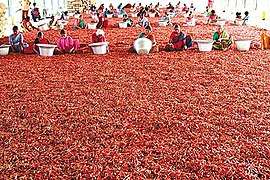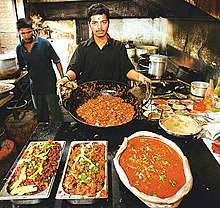Guntur chilli
Guntur chillies is a group of chilli cultivars from Guntur District, Andhra Pradesh, India. They are renowned globally and exported to Asia, Canada, and Europe. Guntur district is the main producer and exporter of most varieties of Chillies and chilli powder from India to countries like Sri Lanka, Bangladesh, Middle East, South Korea, U.K. and USA & Latin America. Chilies have various colors and flavors because of the level of Capsaicin in them. Guntur chilies form an important part of curries and various popular dishes of the state of Andhra Pradesh in India. The main trading place for Guntur chilli is called Guntur Mirchi Yard which is Asia's largest dried red chilli market. Market wise Chilli prices are accessible on National Agriculture Market [1] or e-NAM
| Guntur chilli | |
|---|---|
 Guntur chillies drying in the sun, Andhra Pradesh, India | |
| Species | Capsicum chinense |
| Heat | |
| Scoville scale | 30,000-350,000 SHU |
Guntur chilli cultivators

- 334 chili is a premium export-quality chili.[2]
- Teja chili[3] is a fine variety of Guntur chili.[4]
- Guntur Sannam - S4 Type is the most famous type among the chilis and has a huge demand throughout the world. It widely grows in Guntur, Warangal, and Khammam districts of Andhra Pradesh. The skin of crushed chili is thick, red and hot. It has its peak harvesting season from December to May. The annual Production of this type is approximately 280,000 tons. It has an ASTA Color value of 50-80 and Pungency is 35-45 SHU.
- 273 chili is a common wrinkled chili.
Other Guntur Chilis are Phatki, Indo-5, Ankur, Roshni, Bedki and Madhubala.
References
- "Agriculture marketing: How e-NAM has become an 'inam' for farmers". Indian Express. Indian Express. Retrieved 22 December 2019.
- "Fresh crop seen boosting Guntur chili mandi volumes". Business Standard. 14 June 2013. Retrieved 1 September 2019.
- Fresh arrivals fail to pull down chili prices
- Finer grade of Teja variety fetches Rs. 9,700 per quintal
- "Dried Red Chilli Exports, Guntur Dried Red Chillies Live Rates, Guntur Dried Red Chillies Live Prices, Guntur Mirchi Live Rates, Guntur Mirchi Live Prices, Guntur Market Yard Live Rates, Guntur Mirchi Yard Live Prices, Guntur Mirchi Yard, Guntur Mirchi Exports". gunturmirchi.in. Retrieved 26 September 2019.